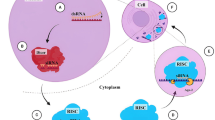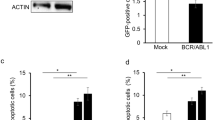Abstract
RNA interference is referred to as the recently discovered process of sequence-specific, post-transcriptional gene silencing that is initiated by double-stranded RNA molecules known as small interfering RNAs (siRNA). We herein present a first report on the in vivo application of targeted non-virally delivered synthetic bcr-abl siRNA in a female patient with recurrent Philadelphia chromosome-positive chronic myeloid leukaemia (CML) resistant to imatinib (Y253F mutation) and chemotherapy after allogeneic haematopoietic stem cell transplantation. We found a remarkable inhibition of the overexpressed bcr-abl oncogene resulting in increased apoptosis of CML cells. In vivo siRNA application was well tolerated without any clinically adverse events. Our findings imply that the clinical application of synthetic siRNA is feasible, safe and has real potential for genetic-based therapies using synthetic non-viral carriers.
Similar content being viewed by others
References
Goldmann JM, Melo JV (2003) Chronic myeloid leukemia — advances in biology and new approaches to treatment. N Engl J Med 349:1451–461
Melo JV (1996) The diversity of BCR-ABL fusion proteins and their relationship to leukemia phenotype. Blood 88:2375–384
Capdeville R, Silberman S (2003) Imatinib: a targeted clinical drug development. Semin Hematol 40:15–0
Hehlmann R, Berger U, Hochhaus A (2005) Chronic myeloid leukemia: a model for oncology. Ann Hematol 84:487–97
Gratwohl A, Baldomero H, Horisberger B et al (2002) Current trends in hematopoietic stem cell transplantation in Europe. Blood 100:2374–386
Goldman J, Gordon M (2006) Why do chronic myelogenous leukemia stem cells survive allogeneic stem cell transplantation or imatinib: does it really matter? Leuk Lymphoma 47:1–
Elbashir SM, Harborth J, Lendeckel W et al (2001) Duplexes of 21-nucleotide RNAs mediate RNA interference in cultured mammalian cells. Nature 411:494–98
Scherr M, Battmer K, Winkler T et al (2003) Specific inhibition of bcr-abl gene expression by small interfering RNA. Blood 101:1566–569
Wohlbold L, van der Kuip H, Miething C et al (2003) Inhibition of bcr-abl gene expression by small interfering RNA sensitizes for imatinib mesylate (ST571). Blood 102:2236–239
Elmaagacli AH, Koldehoff M, Peceny R et al (2005) WT1 and BCR-ABL specific small interfering RNA have additive effects in the induction of apoptosis in leukemic cells. Haematologica 90:326–34
Koldehoff M, Steckel NK, Beelen DW, Elmaagacli AH (2006) Synthetics mall interfering RNAs reduce bcr-abl gene expression in leukaemic cells of de novo Philadelphia (+) acute myeloid leukemia. Clin Exp Med 6:45–7
Dass CR (2004) Lipoplex-mediated delivery of nucleic acids: factors affecting in vivo transfection. J Mol Med 82:579–91
Fattal E, Couvreur P, Dubernet C (2004) ’smart’ delivery of antisense oligonucleotides by anionic pH-sensitive liposomes. Adv Drug Deliv Rev 56:931–46
Hornung V, Guenthner-Biller M, Bourquin C et al (2005) Sequence-specific potent induction of IFN-alpha by short interfering RNA in plasmacytoid dendritic cells through TLR7. Nature Med 11:263–70
Elmaagacli AH, Freist A, Hahn M et al (2001) Estimating the relapse stage in chronic myeloid leukaemia patients after allogeneic stem cell transplantation by the amount of bcr-abl fusion transcripts detected using a new real-time polymerase chain reaction method. Br J Haematol 113:1072–075
Branford S, Rudzki Z, Walsh S et al (2002) High frequency of point mutation clustered within the adenosine triphosphate-binding region of BCR/ABL in patients with chronic myeloid leukaemia or Ph-positive acute lymphoblastic leukaemia who develop imatinib (STI571) resistance. Blood 99:3472–475
Sewell KL, Geary RS, Baker BF et al (2002) Phase I trial of ISIS 104838, a 2’ methoxyethyl modified antisense oligonucleotide targeting tumor necrosis factor-α. J Pharm Exp Ther 303:1334
O’Brien SM, Cunningham CC, Golenkov AK et al (2005) Phase I and II multicenter study of oblimersen sodium, a Bcl-2 antisense oligonucleotide, in patients with advanced chronic lymphocytic leukaemia. J Clin Oncol 23:7697–702
Kretschmer-Kazemi Far R, Sczakiel G (2003) The activity of siRNA in mammalian cells is related to structural target accessibility: a comparison with antisense oligonucleotides. Nucleic Acids Res 31:4417–424
Goldman J (2004) Monitoring minimal residual disease in BCR-ABL-positive chronic myeloid leukaemia in the imatinib era. Curr Opin Hematol 12:33–9
Branford S, Rudzki Z, Walsch S et al (2003) Detection of BCR-ABL mutations in patients with CML treated with imatinib is virtually always accompanied by clinical resistance, and mutations in the ATP phosphate-binding loop (P-loop) are associated with a poor prognosis. Blood 102:276–83
Wilda M, Fuchs U, Wössmann W, Borkhardt A (2002) Killing of leukemic cells with a BCR/ABL fusion gene by RNA interference. Oncogene 21:5716–724
Guo W, Lee RJ (2000) Efficient gene delivery using anionic liposome-complexed polyplexes (LPDII). Biosci Rep 20:419–32
Patil SD, Rhodes DG, Burgess DJ (2005) Biophysical characterization of anionic lipoplexes. Biochim Biophys Acta 1711:1–1
Advani R, Peethambaram P, Lum BL et al (2004) A phase II trial of aprinocarsen, an antisense oligonucleotide inhibitor of protein kinase C alpha, administered as a 21-day infusion to patients with ovarian carcinoma. Cancer 100:321–26
Marcucci G, Byrd JC, Dai G et al (2003) Phase 1 and pharmacodynamic studies of G3139, a BCL-2 antisense oligonucleotide, in combination with chemotherapy in refractory or relapsed leukemia. Blood 101:425–32
Author information
Authors and Affiliations
Corresponding author
Rights and permissions
About this article
Cite this article
Koldehoff, M., Steckel, N.K., Beelen, D.W. et al. Therapeutic application of small interfering RNA directed against bcr-abl transcripts to a patient with imatinib-resistant chronic myeloid leukaemia. Clin. Exper.Med. 7, 47–55 (2007). https://doi.org/10.1007/s10238-007-0125-z
Received:
Accepted:
Published:
Issue Date:
DOI: https://doi.org/10.1007/s10238-007-0125-z




